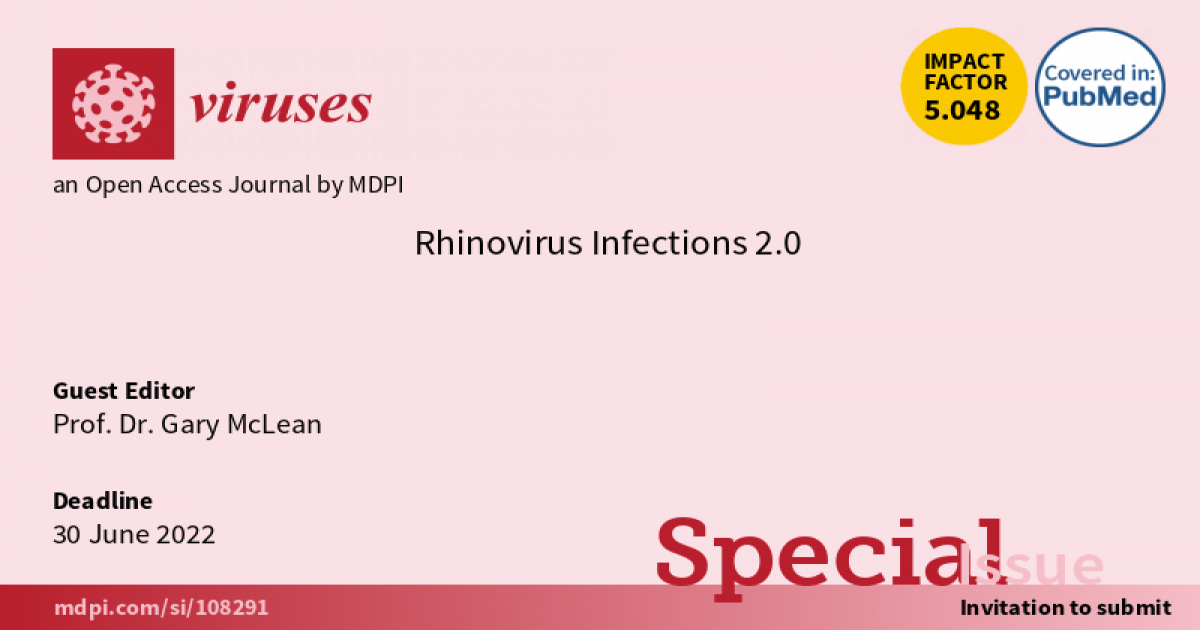Rhinovirus Infections 2.0
A special issue of Viruses (ISSN 1999-4915). This special issue belongs to the section "Animal Viruses".
Deadline for manuscript submissions: closed (30 September 2022) | Viewed by 22281

Special Issue Editor
2. Faculty of Medicine, National Heart & Lung Institute, Imperial College London, London, UK
Interests: rhinovirus; HCMV; HIV; monoclonal antibodies; vaccines
Special Issues, Collections and Topics in MDPI journals
Special Issue Information
Dear Colleagues,
Rhinoviruses are small nonenveloped RNA viruses belonging to the family Picornaviridae, and are recognized as the major cause of common colds and acute exacerbations of asthma and chronic obstructive pulmonary disorder (COPD) in humans. These viruses are extremely antigenically diverse in structure, with approximately 160 distinct serotypes/strains grouped into three types, A, B, and C, with further distinctions based on entry receptor requirements where three different cell-surface molecules have been described. Immunity to rhinoviruses is generally considered to be serotype-specific. Despite intensive studies since their discovery in the 1960s, no effective antiviral or vaccine has been invented to combat these ubiquitous pathogens. Thus, humans can expect to have three to five infections per year, and significantly more in children.
In this updated Special Issue of Viruses, we aim to gather research and review papers that contribute to an improved understanding of rhinovirus structure, classification, infections, epidemiology, and immunopathology, or that report the development of vaccines or antiviral agents. Studies that address rhinovirus infections epidemiology during the COVID-19 pandemic are particularly encouraged.
Prof. Dr. Gary McLean
Guest Editor
Manuscript Submission Information
Manuscripts should be submitted online at www.mdpi.com by registering and logging in to this website. Once you are registered, click here to go to the submission form. Manuscripts can be submitted until the deadline. All submissions that pass pre-check are peer-reviewed. Accepted papers will be published continuously in the journal (as soon as accepted) and will be listed together on the special issue website. Research articles, review articles as well as short communications are invited. For planned papers, a title and short abstract (about 100 words) can be sent to the Editorial Office for announcement on this website.
Submitted manuscripts should not have been published previously, nor be under consideration for publication elsewhere (except conference proceedings papers). All manuscripts are thoroughly refereed through a single-blind peer-review process. A guide for authors and other relevant information for submission of manuscripts is available on the Instructions for Authors page. Viruses is an international peer-reviewed open access monthly journal published by MDPI.
Please visit the Instructions for Authors page before submitting a manuscript. The Article Processing Charge (APC) for publication in this open access journal is 2600 CHF (Swiss Francs). Submitted papers should be well formatted and use good English. Authors may use MDPI's English editing service prior to publication or during author revisions.
Keywords
- rhinovirus
- infections
- immunopathology
- vaccines
- T cells
- antibodies
Benefits of Publishing in a Special Issue
- Ease of navigation: Grouping papers by topic helps scholars navigate broad scope journals more efficiently.
- Greater discoverability: Special Issues support the reach and impact of scientific research. Articles in Special Issues are more discoverable and cited more frequently.
- Expansion of research network: Special Issues facilitate connections among authors, fostering scientific collaborations.
- External promotion: Articles in Special Issues are often promoted through the journal's social media, increasing their visibility.
- e-Book format: Special Issues with more than 10 articles can be published as dedicated e-books, ensuring wide and rapid dissemination.
Further information on MDPI's Special Issue polices can be found here.






